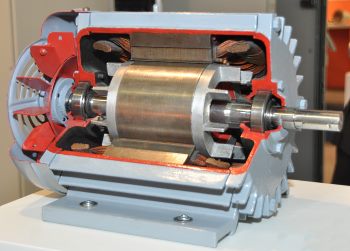property>frequency voltage ratio
What is Frequency To Voltage Ratio?

Frequency Voltage ratio has units of V/Hz, and is most commonly applied to the design of variable frequency motors or drives. Ever since Nikola Tesla and Westinghouse effectively won the AC/DC battle against Edison, alternating current has been in widespread use across the world for electrical power transmission. Not all equipment is designed for AC, and usually electronic devices need a DC (direct current) power supply which steps down the voltage, rectifies and regulates it. But most large electrical motors, including in domestic appliances, are designed to work with an AC supply, and for industrial motors this is usually three-phase.
Typically, for a motor with p magnetic poles, its rotation rate will depend on the frequency of the alternating current by the following equation:
n = 120.f / p
where n is equal to the number of rotations per minute of the motor, f is frequency of the AC power supply, and p is the number of poles on the motor. By poles, we are imagining a simplified motor that is similar to a water wheel with many magnetic rods that run through the middle and cause a torque on the wheel by moving as a result of the magnetic flux from the inductor.
One might want to change the rate of motion of the motor for several reasons, for example if one were using a motor for manufacturing purposes, one might want to slow down the production speed. This is achieved using variable frequency drives (VFD or VSD for variable speed drive, or speed controller) which use high power semiconductors to control the frequency of the supply. VFDs have applications including ventilation systems for large buildings, conveyor belts, pumps and many more. Problems can arise, however, when changing the frequency of the AC power that the motor receives. This is where the frequency/voltage ratio becomes important because the strength of the magnetic field produced is proportional to the frequency/voltage ratio.
Suppose you want to slow down the conveyor belt motor by reducing the frequency of the AC current it draws. If you were to only modify the frequency of the driving alternating current, the voltage will be maintained for a longer period for each cycle, and this results in a higher magnetic flux. This can cause the motor to operate outside its design range and result in increased torque, magnetic saturation and overheating. The solution is to decrease the voltage and the frequency of the AC source at the same time, thus maintaining the same frequency/voltage ratio. As a rule, for a motor running on variable frequency AC, it is necessary to keep the frequency/voltage ratio constant.